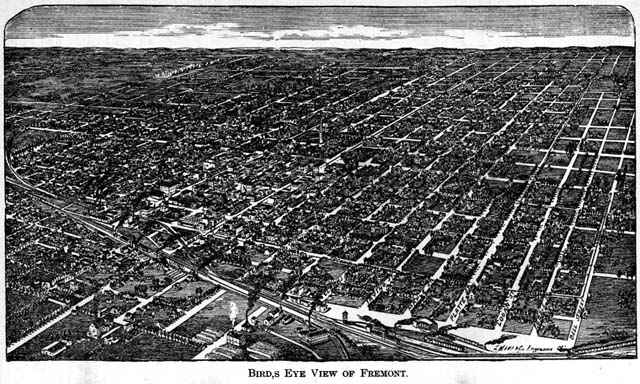| 106 |
NEBRASKA'S ENTERPRISING CITIES.
|

Few cities in any country have natural resources and acquired advantages of so high an order as the City of Fremont. Men have come here with limited means, and in a few years have built up, out of the inexhaustible resources that gather at this place, the foundations of handsome, even princely, fortunes--fortunes such as have enabled them to extend their operations in live stock, real estate, mining, finance, etc., clear through to the Pacific and south to the Gulf.
It is situated in the great Platte Valley at its junction with the valley of the Elkhorn River, in the second tier of counties from the east end of the State. These valleys in this section of the State are of wonderful fertility. Agricultural valleys of like magnitude and fertility in the old world are literally burdened with their swarming masses of population. Our wide uplands are not less fertile and lasting. The crops are of uniform, never-failing excellence year after year without interruption.
The world over it is the rich agricultural districts that teem with people and have a solid, enduring prosperity. Fremont's local territory has not a foot of waste or inferior land. The same is true of a wide surrounding jobbing district. Up these river valleys, and along their branches, extend powerful railroad lines out in every direction from Fremont, making these fertile valleys and vast rich uplands intervening tributary to our city.
Fremont's fundamental resources are attested by the facts:
That Dodge and Saunders Counties--both of which are tributary in a business way to Fremont--produce 13,000.000 bushels of corn per annum, a product equal to that of entire States further east.
That the east one-third of Nebraska, Fremont's more special jobbing territory, produces 170.000.000 bushels of corn per annum.
That 200,000 tons of native hay are put up each year on the Platte Valley lands of Dodge, Fremont's home county.
That Fremont is the center of a remarkable live stock business. In the combined magnitude of its varied interests, beef cattle, sheep, horses, swine, blooded stock, dairy interests, few cities west of the Mississippi compare with it.
That 150,000 sheep are brought to Fremont each winter and fattened within a radius of eight miles from the city, for the eastern markets. In 1890 the number reached 200,000.
That 15,000 head of cattle are similarly fed annually within the same radius. The most extensive cattle feeding establishments in the world are located here.
That 300,000 head of cattle find their way to market annually through this junction point, over the Union Pacific and Fremont, Elkhorn & Missouri Valley Railroads.
That 700,000 to 800,000 hogs are shipped annually over these lines from the more immediate vicinity of Fremont.
That the Fremont Creamery produces 500,000 pounds of butter per annum.
That the Platte Valley lands at Fremont are producing hemp in quantity and quality equal to the best Kentucky lands.
That this is the natural soil and climate for the sugar beet, Nebraska's future great industry.
That the soil in its natural state without fertilizers yields vegetables and produce of every kind enormously.
TRANSPORTATION.
Next in importance, as a basis of the city's growth and prosperity, to the splendid agricultural country back of it, are the superior railroad facilities by which it reaches that territory.
The following is the list of present lines: Union Pacific, overland main line; Republican Valley branch from a point ten miles east; Loup Valley branches from points farther west; Sioux City & Pacific main line, eastward into Iowa; Fremont, Elkhorn & Missouri Valley (Chicago & North-Western in Nebraska, Wyoming and Dakota), main line; Lincoln branch, direct from Fremont to Lincoln. Nebraska; Superior branch, direct from Fremont to the Kansas State line; Hastings branch, direct from Fremont to central south Nebraska; Albion branch, direct from Fremont to central north Nebraska; Omaha branch, direct from Fremont to Omaha, Nebraska. Travelers can go to any point of the compass at almost any hour of the day. Freight received and shipped out from the local depots of the city in 1891 yielded a revenue of more than a million dollars to the companies. There are twenty-four passenger trains daily.
The bank deposits of Dodge County, of which Fremont is the capital, are twenty-five per cent. higher than any county in the State, and seventy-five per cent, higher than the average in the State. In this comparison Douglas County (Omaha) is left out. it being, as the clearing house city, an unfair comparison with other counties.
Fremont has four national banks, with a combined capital of $750,000 and combined average deposits of $950 000. There are two savings banks two incorporated trust and mortgage companies, with combined paid-up capital of $340,000.
JOBBING TRADE.
Fremont's wholesale and jobbing trade has, through its superior railway system and strong enterprising concerns grown to important proportions. The volume of trade in 1891 was $6,000,000. It started up a dozen or more years ago, upon the completion of a competing short line to Chicago, and holds its own in competi-
| 106 |
NEBRASKA'S ENTERPRISING CITIES.
|

|
© 2002 for the NEGenWeb Project by Pam Rietsch, Ted & Carole Miller |
||